| Massage and the Original Swedish Movements | ||
DIVISION OF MOVEMENTS
Ling and his pupils divided the movementsinto:
- 1. Single.
- 2. Double.
The single movements they again subdivided into passive and active, and the double movements into concentric and excentric.
Passive movements are such as are applied to the patient without his assistance. (They may be performed by an operator, by a machine, or through the power of gravity.)
Active movements are performed by thepatient.
Concentric (active-passive) movements are performed by the patient, while the operator or some other power resists.
Excentric (passive-active) movements are performed by some power outside of the patient, while he resists.
The principal difference between the concentric and excentric movements is that in the former the muscle is shortened, in the latter it is stretched. As to their nature and physiologic action, it is easy to understand that they are but little different from the single active movements. Practically they are of great use, as by them we are able to exactly fix the amount of mechanical work done by the patient in each movement.
To make the terminology somewhat simpler for the reader, we have in the description of the movements used the expression duplicated active movements, by that covering both concentric and excentric movements in the Ling system.
- 1. Rotation.
- 2. Flexion and Extension.
- 3. Separating and Closing.
- 4. Bending.
- 5. Raising.
- 6. Pulling.
- 7. Turning.
- 8. Depression and Elevation.
THE VARIOUS MOVEMENTS
- Rotation is a circular movement by which the different joints are brought into motion within their natural limits.
I. Rotation of the feet may be performed with the patient in a sitting or half-lying position.
In the first position, the operator sits in front of the patient and, taking the feet in his lap, grasps the toes and moves the feet outward, describing a circle. In the second position, the patient is half-lying, his feet resting on the couch or bed. The operator grasps the toes and proceeds with the same
motion as above. Relax the muscles, if necessary, by shaking the toes.78The rotation of the feet is intended to promote circulation in the lower extremities and is often used for attracting the blood from other parts. The movement is performed fifteen to thirty times. The strength of the motion depends upon the size of the circle described. (Passive.)
- II. Rotation of the Foot.—The operator, sitting in front of the patient, takes the heel in his left hand and grasping the toes with the right, performs a rotatory motion from the ankle, pressing the foot forward. Ten to fifteen times in each series. It is used principally for deformities and affections of the feet. (Passive.)
- III. Rotation of the Leg.—The patient is in a half-lying position. The operator, placing one hand on the sole of the foot and the other below the knee, with the thumbs inward, raises the leg and performs a circular motion by the hip-joint; pressing upward, inward and outward. Twelve to fifteen times on each limb. It is used to regulate the circulation of the abdominal organs and to prevent stiffness in the hip-joint. (Passive or Active.)
- IV. Rotation of the Arms.—The patient sitting. The
operator, standing behind, grasps the extended arms below the elbows and
rotates them upward and outward. The patient may also be in a standing
position, in which case the operator must support
him with his chest. It is used principally to assist respiration and circulation. (Passive or Active.)79
- V. Rotation of the Shoulder.—The patient sitting or standing. The operator, putting one hand on the shoulder-joint and the other below the elbow, rotates upward and outward. Fifteen to twenty times. The movement is used for stiffness in the joint and for inflammation of certain muscles. (Passive.)
- VI. Rotation of the Hand.—The operator takes the patient's hand, and, grasping the wrist with his free hand, rotates from side to side. Ten to eighteen times. It is used for stiffness in the wrist after fractures of the arm; also to increase the circulation. (Passive.)
- VII. Rotation of the Head.—The patient sitting with the back supported. The operator, placing one hand on the forehead and the other on the neck, rotates SLOWLY from side to side. Eight to ten times. It is used for anemia of the brain, stiffness of the neck, and insomnia, etc. (Passive.)
- VIII. Rotation of the Body.—The patient in a
sitting position, with hands on hips. The operator standing behind,
places his right hand on the right shoulder-blade, and his left in
front, on the chest of the left side, and performs the motion in such a
way as to press the patient forward with one hand and carry him backward
with the other, always being careful to describe a circle. When the
movement is performed to one side ten to fifteen times, change
the position of the hands and rotate toward the other side. It is used principally for affections of the abdomen. To secure a very strong action of the movement, the patient turns his body somewhat in the motion. (Passive.)80
IX. Rotation of the Pelvis.—The patient resting with body on a couch or bed, and grasping it to keep immovable, the lower extremities extended. The operator grasps the feet and proceeds with the rotation
of the legs, endeavoring to produce a circle large enough to bring the pelvis into action.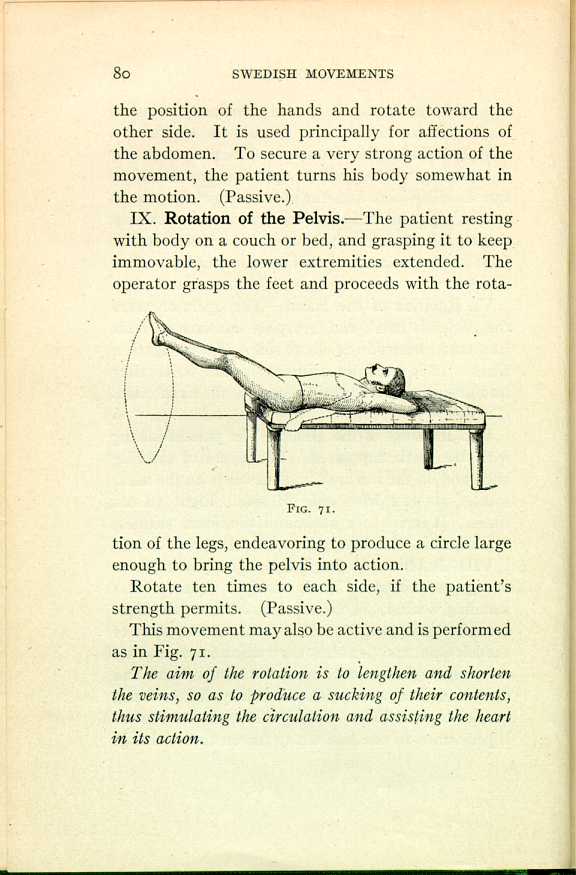
FIG. 71.
[Description: Drawing of a man lying on a couch with his legs raised in the air. Dotted lines indicate circular movement. ]Rotate ten times to each side, if the patient's strength permits. (Passive.)
This movement may also be active and is performed as in Fig. 71.
The aim of the rotation is to lengthen and shorten the veins, so as to produce a sucking of their contents, thus stimulating the circulation and assisting the heart in its action.
81
I. ROTATION
I. Foot.—The patient lying or sitting. The operator, grasping the ankle with one hand and the toes with the other, moves the foot up and down as far as the limits of the joint permit. Ten to eighteen times. It is used for deformities, and especially for stiffness of the Achilles tendon. (Passive and Duplicated Active.)
The movement may also be performed on both feet at the same time, as demonstrated in Fig. 72.
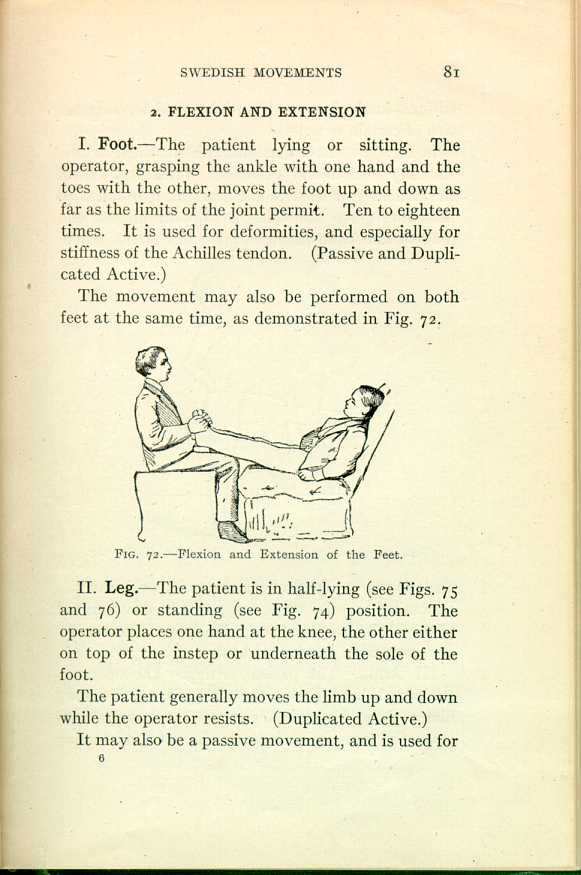
FIG. 72.—Flexion and Extension of the Feet.
[Description: Drawing of a patient reclining in a chair, his legs outstretched; an operator sits opposite him, holding the patient's feet. ]II. Leg.—The patient is in half-lying (see Figs. 75 and 76) or standing (see Fig. 74) position. The operator places one hand at the knee, the other either on top of the instep or underneath the sole of the foot.
The patient generally moves the limb up and down while the operator resists. (Duplicated Active.)
It may also be a passive movement, and is used for
stiffness in the knee and hip-joint, and for contraction of certain muscles.82In Fig. 73 we have demonstrated the single active, standing flexion and extension of the leg. Until the patient gets used to the exercise, it is safest to have him grasp something to support himself and prevent him from falling. The effect of this movement
is not confined to the extremity only, but the abdominal muscles are strongly and effectively acted upon. It is therefore very valuable in the treatment of constipation and hemorrhoids.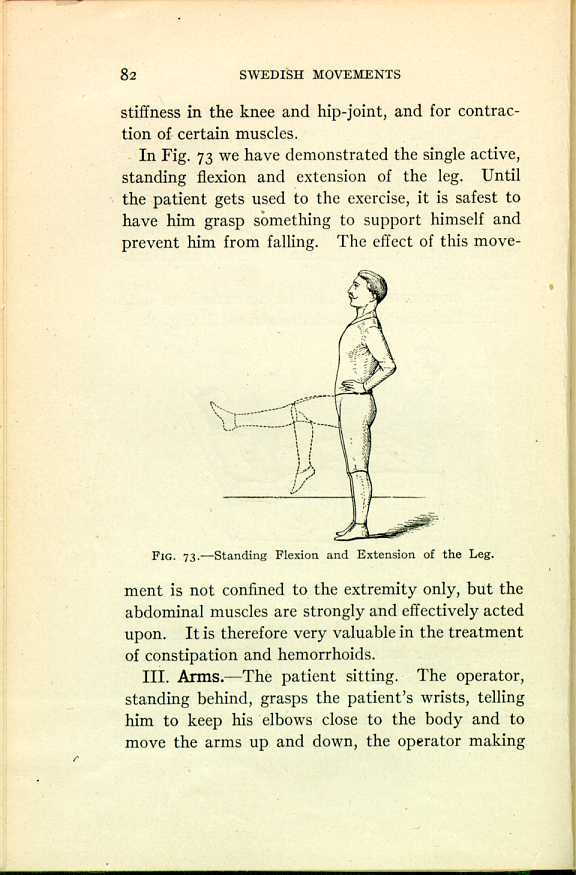
FIG. 73.—Standing Flexion and Extension of the Leg.
[Description: Drawing of a man standing. Dotted lines indicate flexion and extension of the leg. ]- III. Arms.—The patient sitting. The operator,
standing behind, grasps the patient's wrists, telling him to keep his
elbows close to the body and to move the arms up and down, the operator
making
suitable resistance. Ten times. It is a circulatory movement. (Duplicated Active.)83
- IV. Arm.—The patient sitting. The operator,
standing in front, grasping the wrist with one hand and around the
triceps muscle with the other, the patient moves the arm up and down,
the operator making suitable resistance. Ten to fifteen times.
The motion may also be passive, and is used for acting upon the joints and for certain local affections. (Passive or Duplicated Active.)
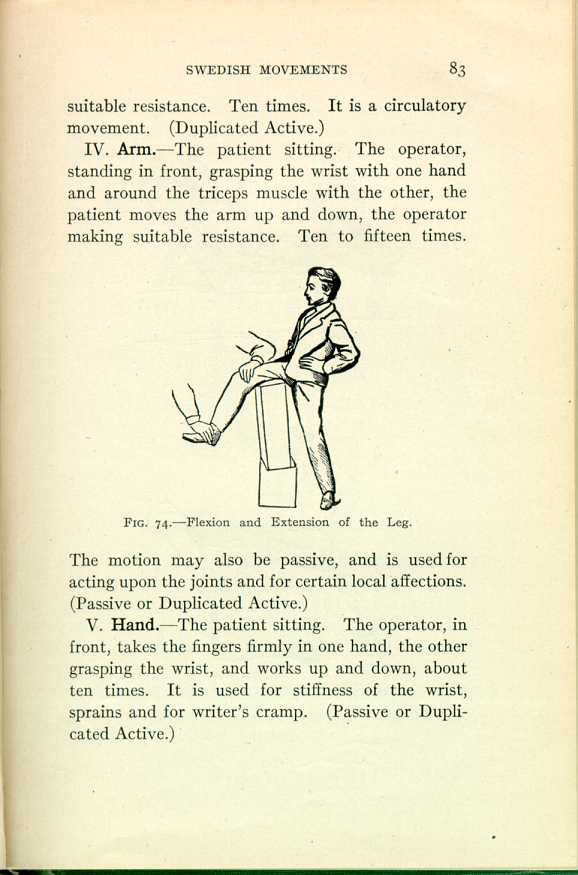
FIG. 74.—Flexion and Extension of the Leg.
[Description: Drawing of a man standing, his left leg positioned over some blocks. ] - V. Hand.—The patient sitting. The operator, in
front, takes the fingers firmly in one hand, the other grasping the
wrist, and works up and down, about ten times. It is used for stiffness
of the wrist, sprains and for writer's cramp. (Passive or Duplicated
Active.)
84
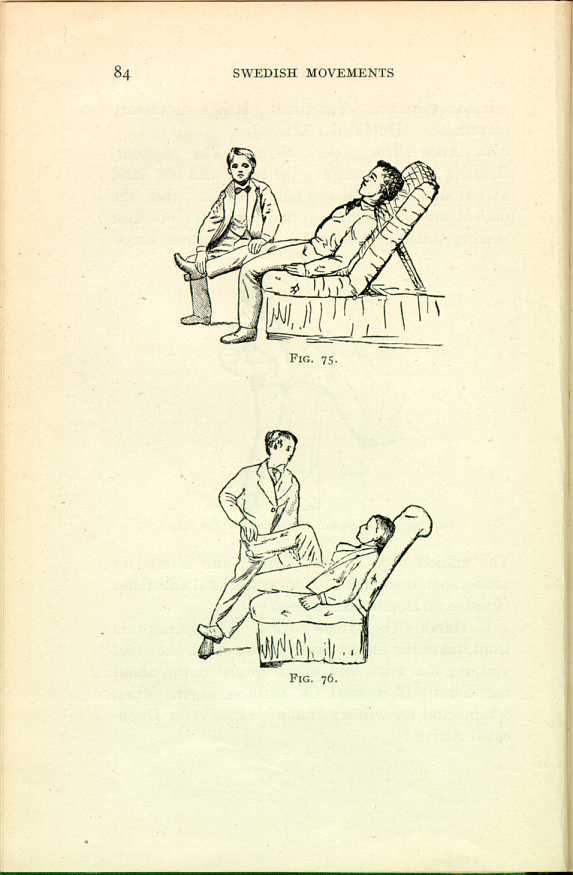
FIG. 75.
[Description: Drawing of a patient sitting in a reclining chair, his left foot on the floor and his right leg extended; on operator sits next to him holding his extended leg. ]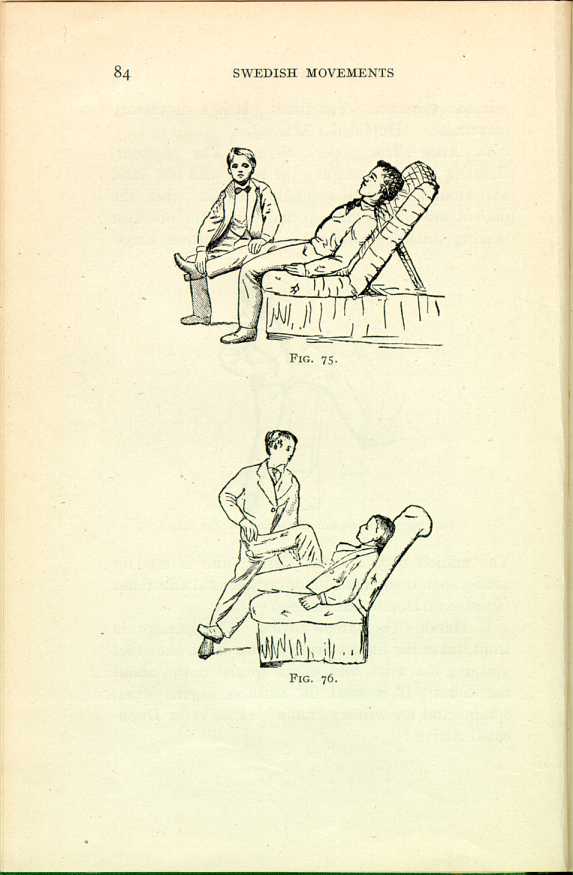
FIG. 76.
[Description: Drawing of a patient sitting in a reclining chair; an operator stands next to him, pushing the patient's bended leg toward his body. ]85
2. FLEXION AND EXTENSION
Flexion and extension are used principally for regulating the
circulation in certain parts and for relieving local congestion.
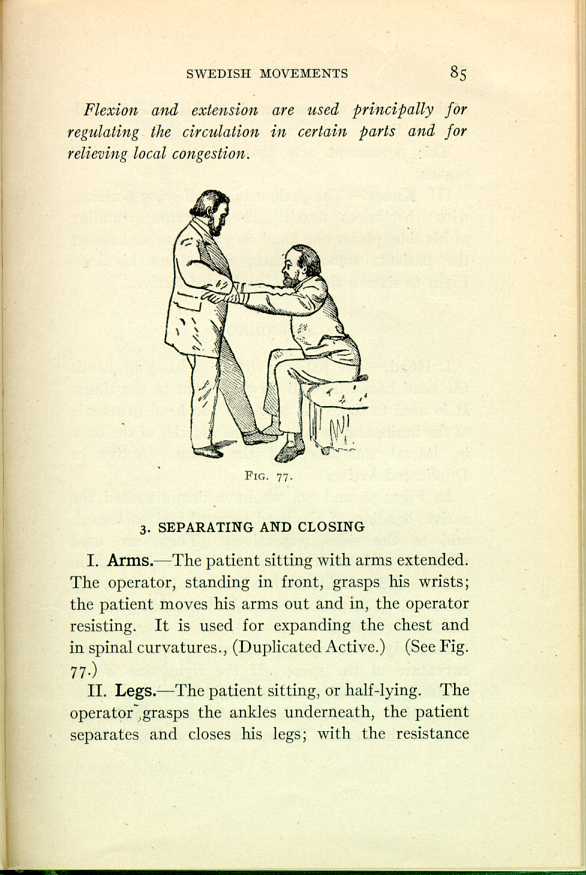
FIG. 77.
[Description:
Drawing of a patient sitting on a chair, his arms stretched out in
front of him; an operator stands in front of him holding his
outstretched arms.
]
- I. Arms.—The patient sitting with arms extended. The operator, standing in front, grasps his wrists; the patient moves his arms out and in, the operator resisting. It is used for expanding the chest and in spinal curvatures., (Duplicated Active.) (See Fig. 77.)
II. Legs.—The patient sitting, or half-lying. The operator grasps the ankles underneath, the patient separates and closes his legs; with the resistance
of the operator, who may need an assistant. (Duplicated Active.)86This movement acts upon different abdominal organs.
- III.Knees.—The patient in a half-lying position, with the knees flexed. The operator, standing at his side, places one hand on each knee and resists the patient, who separates and closes his legs. Eight to sixteen times. (Duplicated Active.)
3. SEPARATING AND CLOSING
I. Head.—The patient, sitting or hanging, bends the head backward and forward eight to ten times. It is used to force the blood to the head in anemia of the brain, and to act upon the muscles of the back in lateral curvature of the spine. (Active or Duplicated Active.)
In Figs. 78 and 79, we have demonstrated the active bending of the head forward and backward, and to the sides respectively. These are used when we wish to draw the blood from the head in full blooded individuals or when we wish to develop the neck. The patient resists himself while performing the movement.
II. Body (sideways).—Suppose a case of lateral curvature of the spine. If the right side is the originally affected one, i.e., right sided convexity, the patient stands with his left arm straight up, close to the head. The operator, standing behind,
87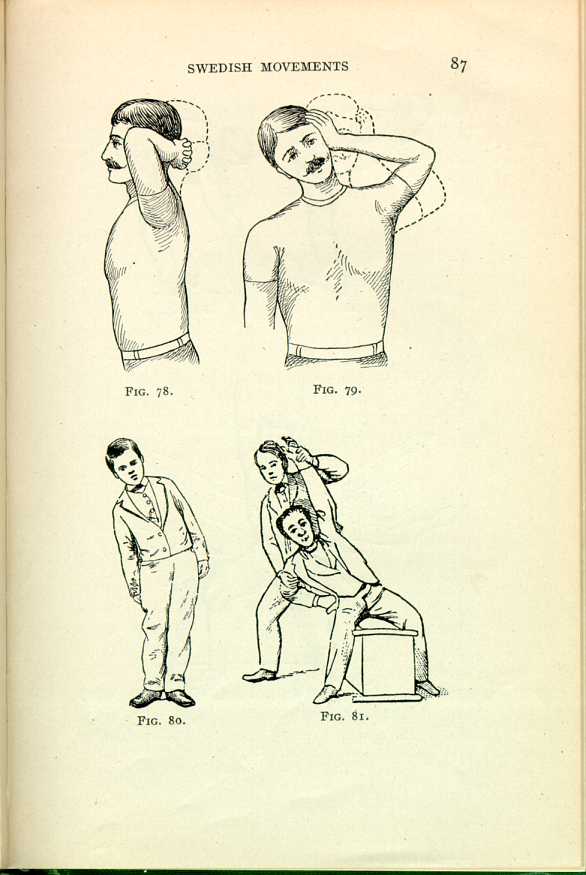
FIG. 78.
[Description: Drawing of a man with his elbows out to the side and his hands behind his head. Dotted lines indicate movement to the back. ]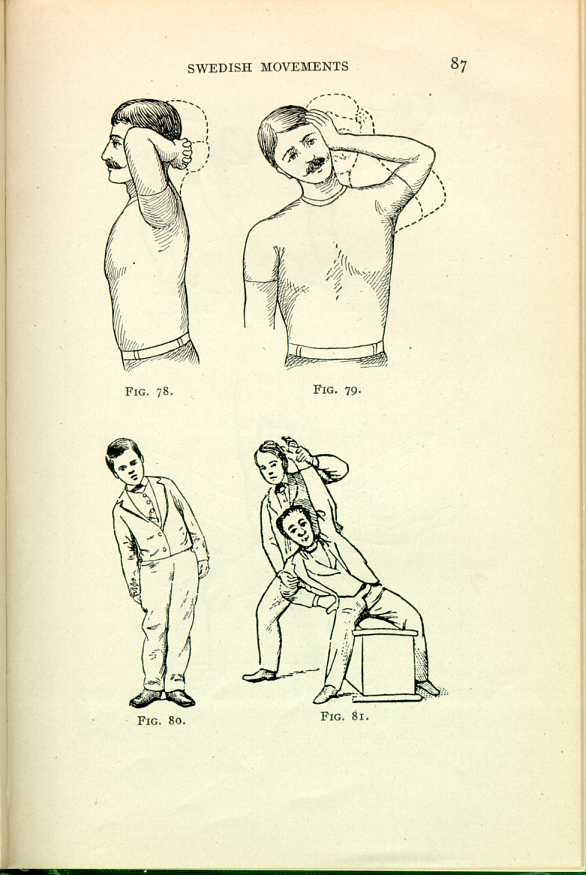
FIG. 79.
[Description: Drawing of a man with his right hand placed against the side of his head. Dotted lines indicate movement to the side. ]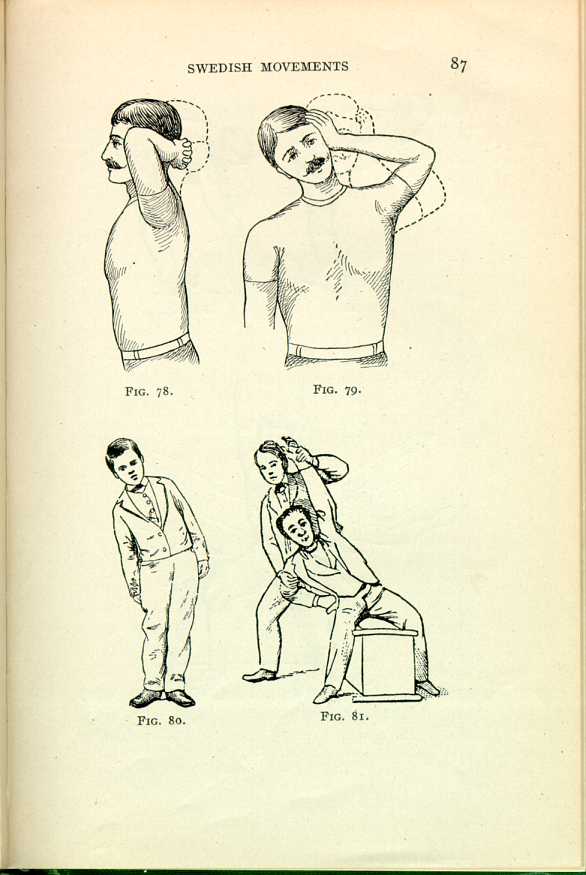
FIG. 80.
[Description: Drawing of a man with his arms at his sides leaning to the right. ]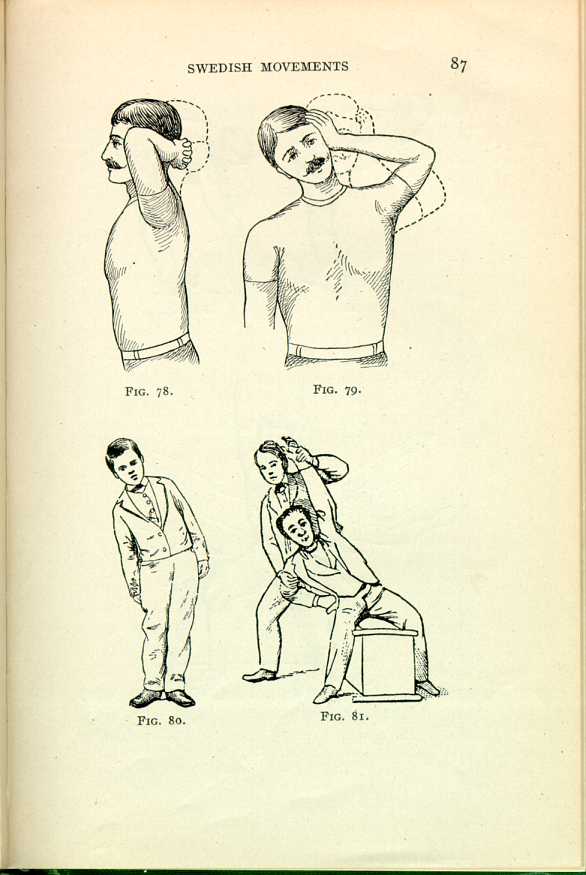
FIG. 81.
[Description: Drawing of a patient straddling a bench with his left arm pointing up; an operator stands behind him holding his extended arm. ]88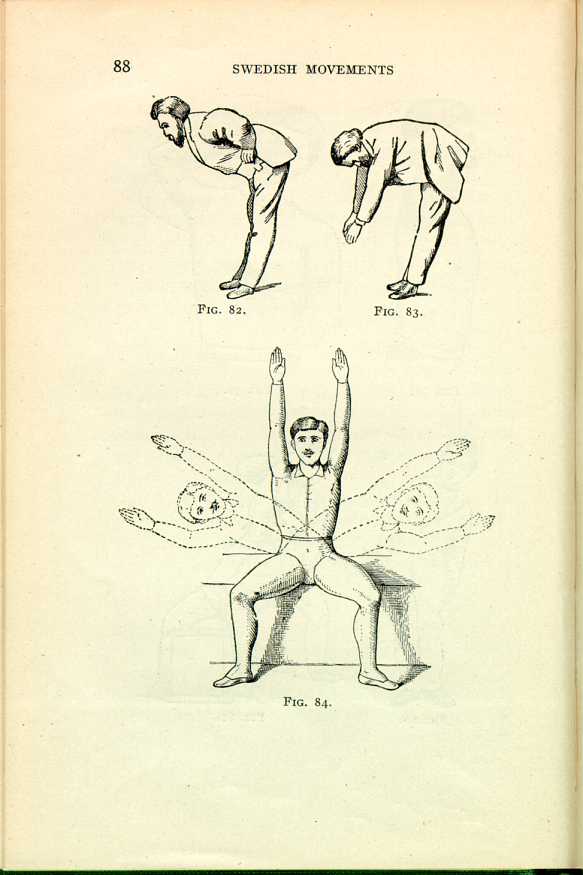
FIG. 82.
[Description: Drawing of a man bent forward at the waist, his hands on his hips. ]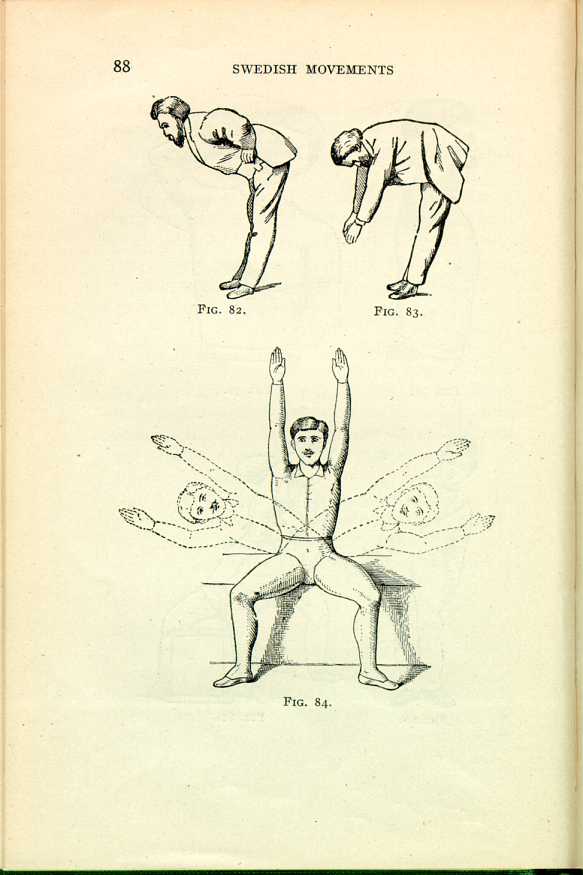
FIG. 83.
[Description: Drawing of a man bent forward at the waist, his arms hanging down. ]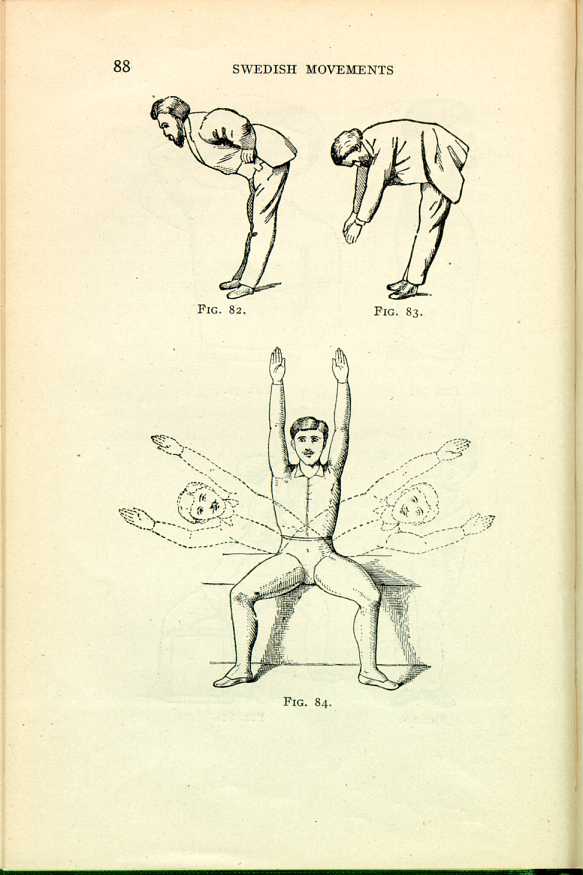
FIG. 84.
[Description: Drawing of a man sitting down, facing front, holding his arms above his head. Dotted lines indicate movement to the left and right. ]places one hand on the right side, at the highest point of curvature, the other on the opposite hip; the patient bends slowly toward the right side,89thus acting upon the affected muscles. The movement may also be single active, as shown in Fig. 80.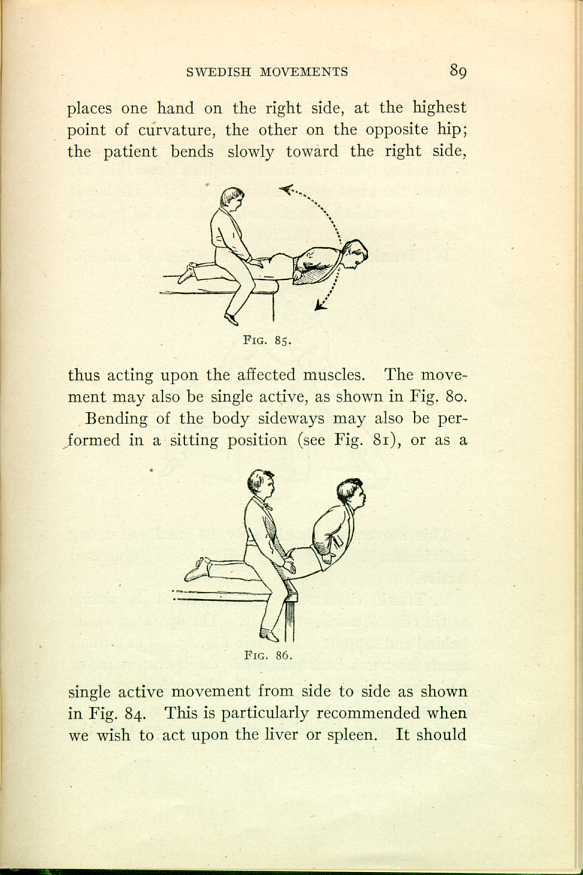
FIG. 85.
[Description: Drawing of a patient lying down on a bench, his upper body extending over the edge, and an operator sitting on his legs. An arrow indicates movement up and down. ]Bending of the body sideways may also be performed in a sitting position (see Fig. 81), or as a
single active movement from side to side as shown in Fig. 84. This is particularly recommended when we wish to act upon the liver or spleen. It should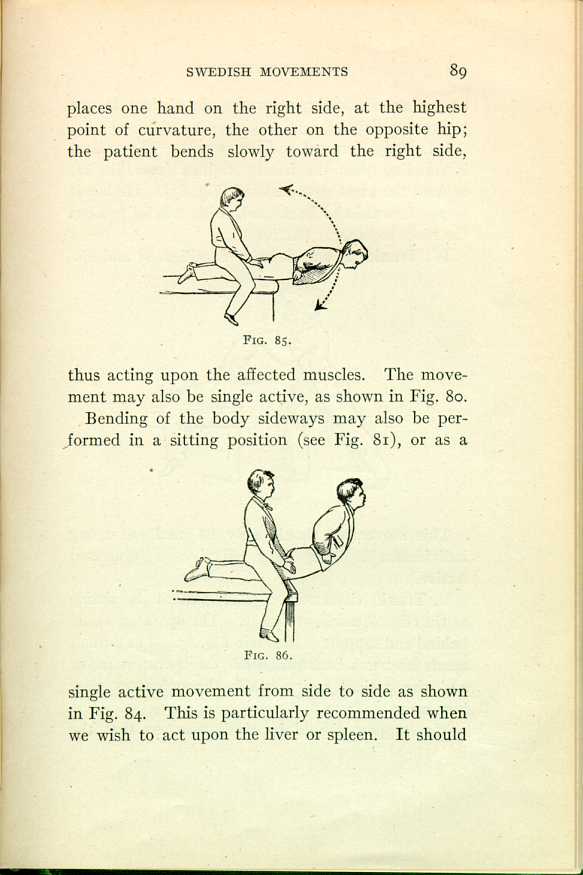
FIG. 86.
[Description: Drawing of a patient lying down on a bench, his upper body extending over the edge and curved up, and an operator sitting on his legs. ]be performed slowly, otherwise the patient is apt to become dizzy.90- III. Body (forward and backward).—The patient is standing with the hands on hips (see Fig. 82) or with the arms stretched (see Fig. 83). He bends slowly forward and backward, being careful to keep the heels together. (Active.)
IV. Trunk (up and down).—See Figs. 85 and 86.
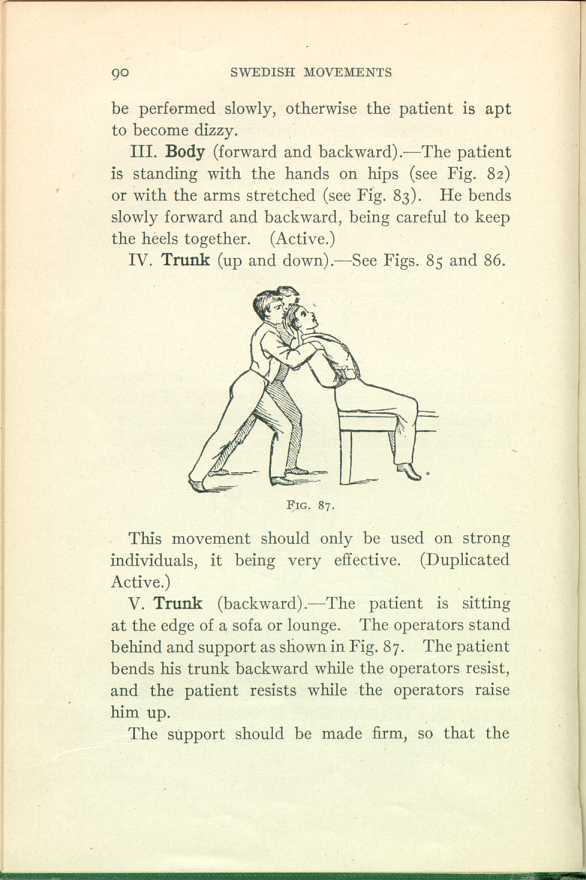
FIG. 87.
[Description: Drawing of a patient sitting on a bench; two operators stand behind him, pulling his shoulders back. ]This movement should only be used on strong individuals, it being very effective. (Duplicated Active.)
V. Trunk (backward).—The patient is sitting at the edge of a sofa or lounge. The operators stand behind and support as shown in Fig. 87. The patient bends his trunk backward while the operators resist, and the patient resists while the operators raise him up.
The support should be made firm, so that the
patient feels confident in performing the movement. It is an excellent exercise to act upon the muscles of the back. (Duplicated Active.)91- VI. Knee.—The operator stands behind the patient,
as demonstrated in Fig. 88, and resists the patient rising. (Duplicated
Active.)
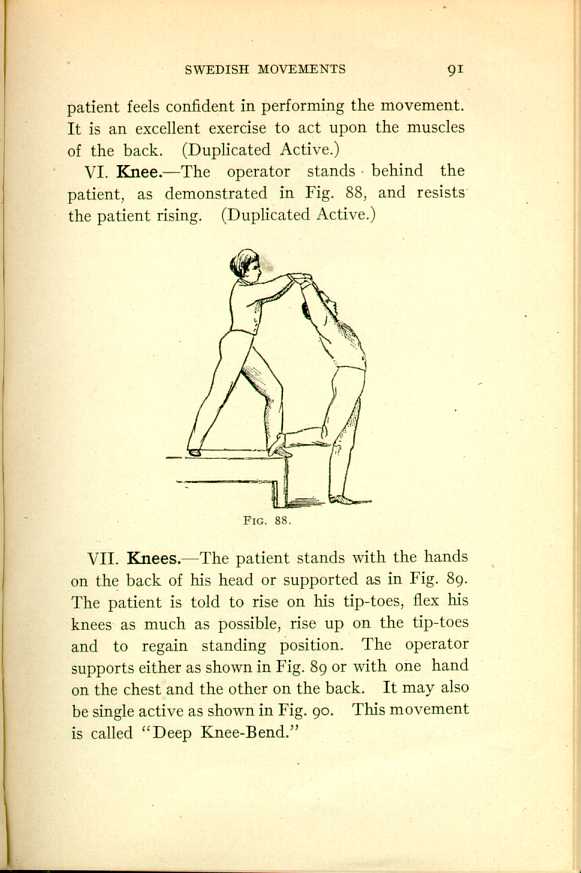
FIG. 88.
[Description: Drawing of a patient standing, his arms raised and his right leg bent at the knee; an operator stands behind him on a bench, pulling back on his raised arms. ] - VII. Knees.—The patient stands with the hands on
the back of his head or supported as in Fig. 89. The patient is told to
rise on his tip-toes, flex his knees as much as possible, rise up on the
tip-toes and to regain standing position. The operator supports either
as shown in Fig. 89 or with one hand on the chest and the other on the
back. It may also be single active as shown in Fig. 90. This movement is
called "Deep Knee-Bend.''
92
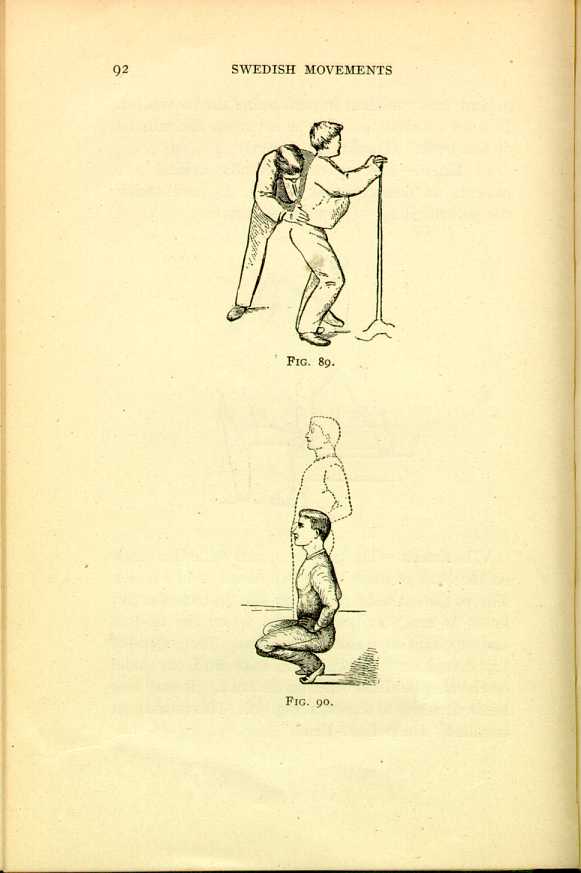
FIG. 89.
[Description: Drawing of a patient with his knees bent, supporting himself with a pole; an operator stands next to him, holding the patient's hips. ]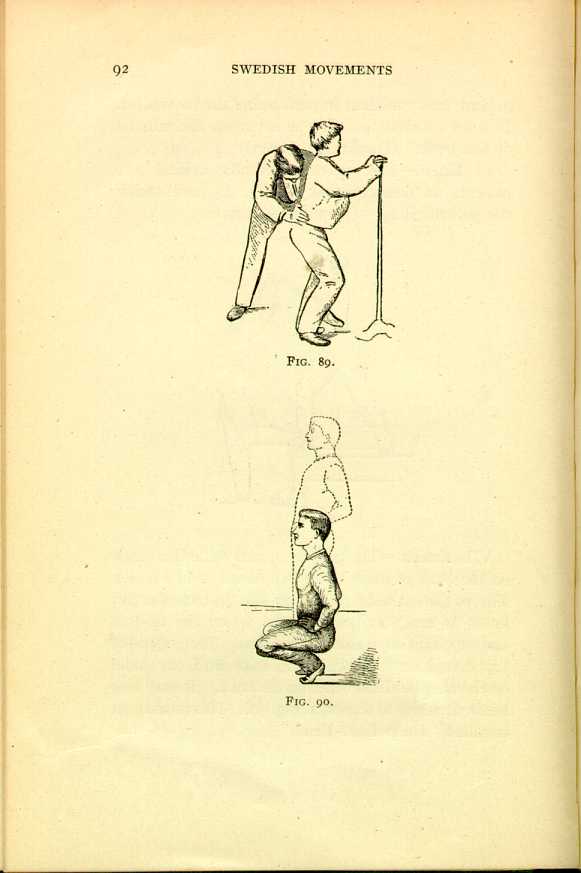
FIG. 90.
[Description: Drawing of a man in a crouched position. Dotted lines indicate movement. ]93
4. BENDING
I. Leg.—The patient lying on his back. The operator grasps the heel underneath, one hand supporting the knee on top and raises the extended leg upward. Ten times.
This movement may also be active and is used principally for sciatica and slight rupture.
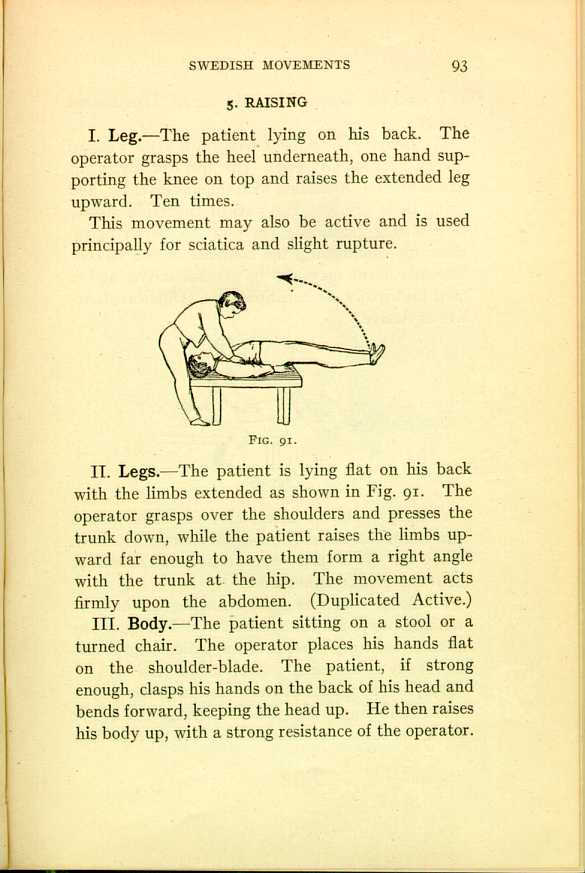
FIG. 91.
[Description: Drawing of a patient lying on a table, his legs extended over the edge; an operator stands behind his head, holding his upper torso. A dotted arrow indicates movement. ]- II. Legs.—The patient is lying flat on his back with the limbs extended as shown in Fig. 91. The operator grasps over the shoulders and presses the trunk down, while the patient raises the limbs upward far enough to have them form a right angle with the trunk at the hip. The movement acts firmly upon the abdomen. (Duplicated Active.)
- III. Body.—The patient sitting on a stool or a
turned chair. The operator places his hands flat on the shoulder-blade.
The patient, if strong enough, clasps his hands on the back of his head
and bends forward, keeping the head up. He then raises his body up, with
a strong resistance of the operator.
It is used for deformities of the back. (Duplicated Active.)94
- IV. Body.—The patient lying with hands clasped on
the back of his head. The operator places his hands around the ankles,
with thumbs inverted, and holds them firmly. The patient then rises
slowly to a sitting position. There is no better movement for
compressing the contents of the bowels. The movement may also be
general active, and is used principally for constipation. (Duplicated
Active or Active.)
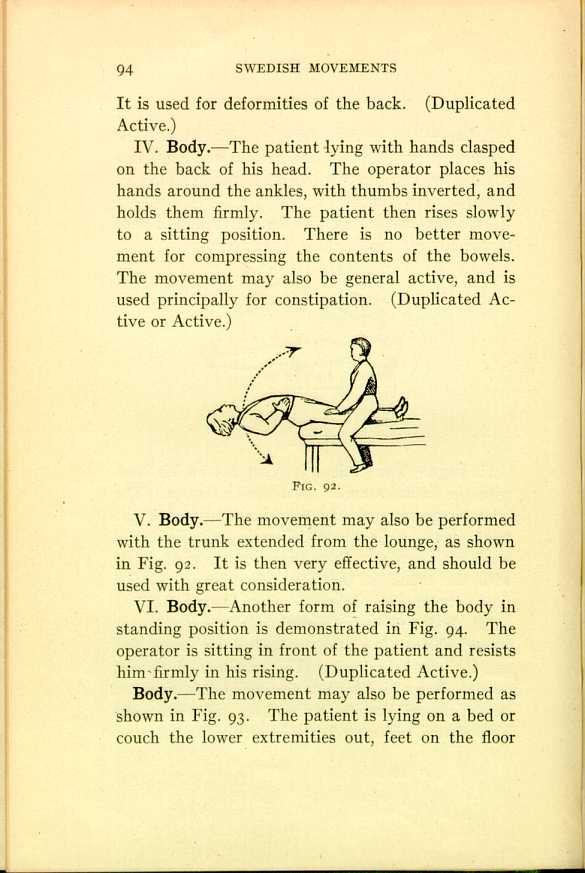
FIG. 92.
[Description: Drawing of a patient lying on his back on a bench, his upper torso extended over the edge. An operator sits on his legs. A dotted arrow indicates movment. ] - V. Body.—The movement may also be performed with the trunk extended from the lounge, as shown in Fig. 92. It is then very effective, and should be used with great consideration.
VI. Body.—Another form of raising the body in standing position is demonstrated in Fig. 94. The operator is sitting in front of the patient and resists him firmly in his rising. (Duplicated Active.)
Body.—The movement may also be performed as shown in Fig. 93. The patient is lying on a bed or couch the lower extremities out, feet on the floor
95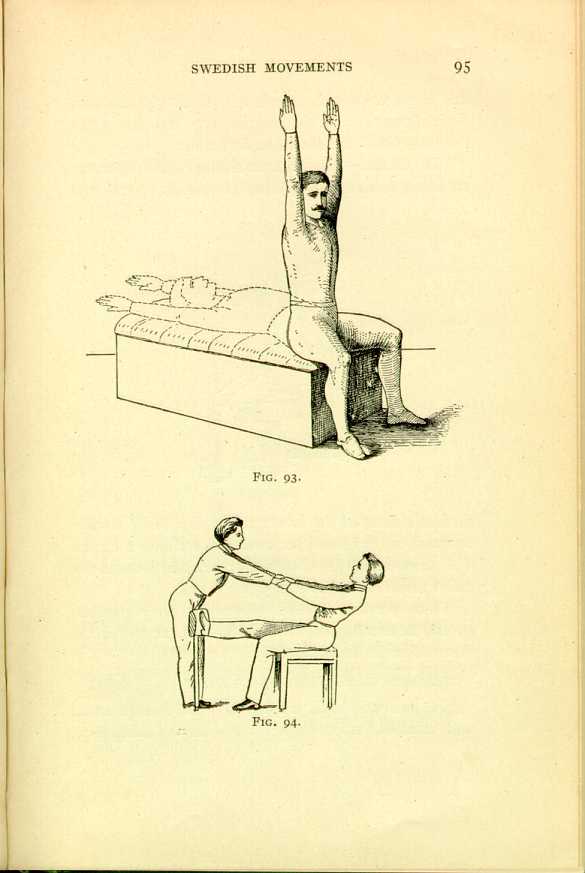
FIG. 93.
[Description: Drawing of a man sitting on a bench, his arms extended over his head. Dotted lines indicated movement to the back. ]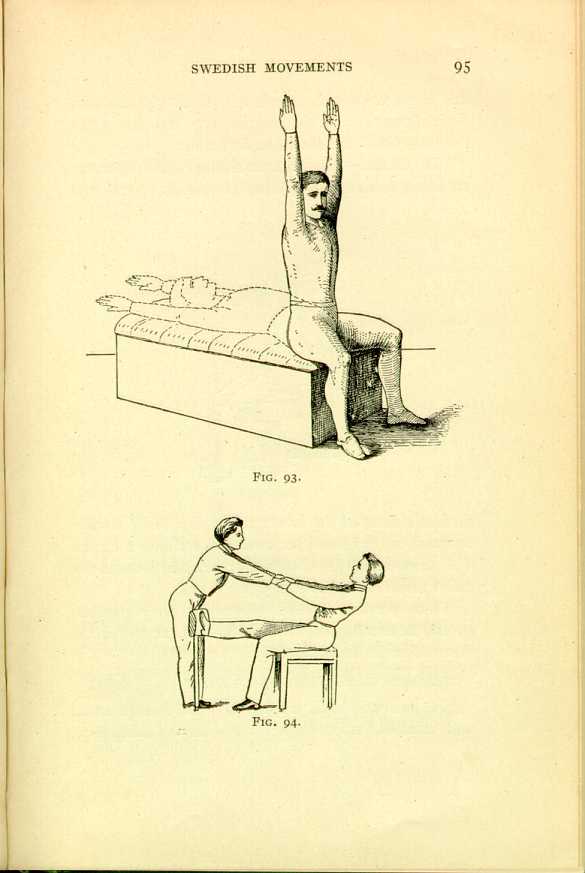
FIG. 94.
[Description: Drawing of an operator standing in front of a seated patient, with the patient pressing his knee against the operator's thigh and holding the operator's hands. ]and arms stretched. He is told to slowly rise to a sitting position. This exercise acts strongly upon the muscles of the abdomen and chest.96VII. Chest.—The patient sitting. The operator standing behind and placing his hands around the
patient's armpits in front, raises the body slowly forward, upward and backward, describing a circle. This movement is always passive, and is used to assist respiration (see Fig. 95).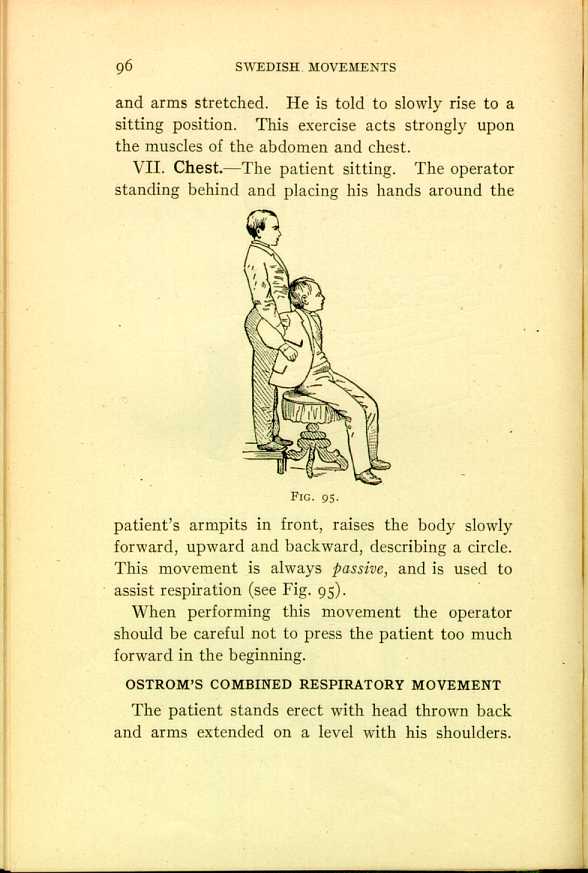
FIG. 95.
[Description: Drawing of an operator standing behind a seated patient, holding the patient's bended arms at the armpits. ]When performing this movement the operator should be careful not to press the patient too much forward in the beginning.
5. RAISING
- The patient stands erect with head thrown back
and arms extended on a level with his shoulders.
97
- 1. Flex the arms slowly under slight resistance (single active), gentle inspiration.
- 2. Expiration.
- 3. Raise the flexed arms up so that the points of the elbows reach above the head, with deep inspiration.
- 4. Expiration while in this position.
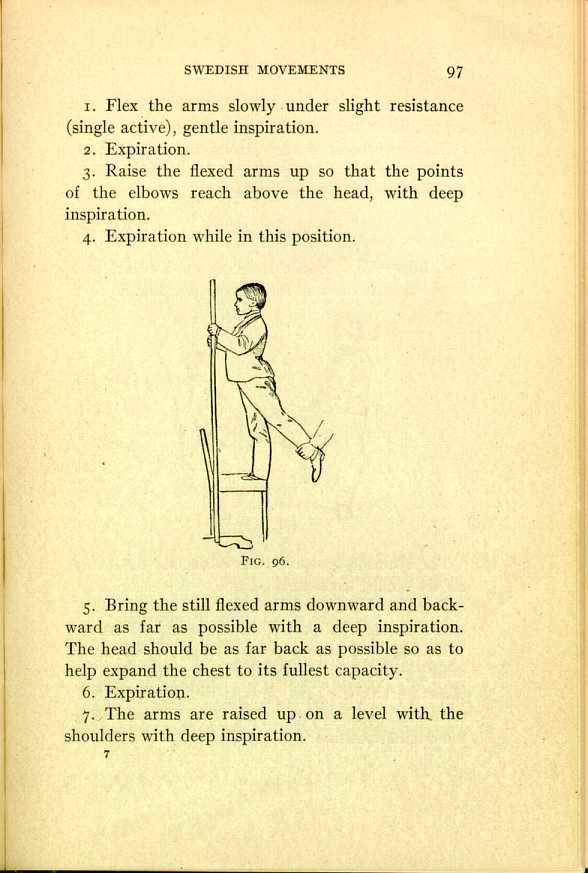
FIG. 96.
[Description: Drawing of a man standing on a chair, grasping a pole. A hand pulls his leg to the back. ] - 5. Bring the still flexed arms downward and backward as far as possible with a deep inspiration. The head should be as far back as possible so as to help expand the chest to its fullest capacity.
- 6. Expiration.
- 7. The arms are raised up on a level with the
shoulders with deep inspiration.
98
- 8. The arms are extended back to their fundamental position slowly, while the patient exhales.
OSTROM'S COMBINED RESPIRATORY MOVEMENT
This movement is very strong and consequently rather tiresome to the patient. It should therefore be given carefully in the beginning.
I. Leg.—The patient standing on a chair, with hands against the wall for support (see Fig. 96).
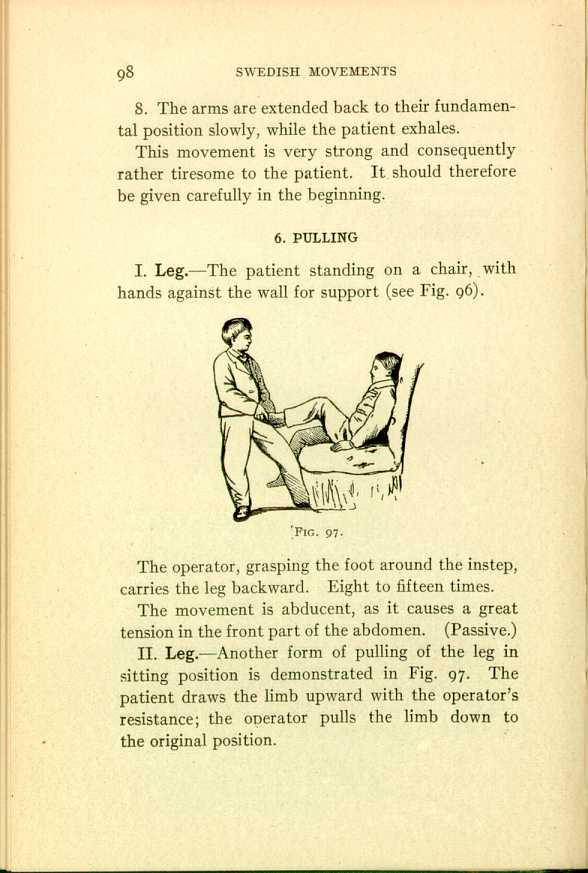
FIG. 97.
[Description: Drawing of an operator standing in front of a seated patient, pulling on the patient's extended leg. ]The operator, grasping the foot around the instep, carries the leg backward. Eight to fifteen times.
The movement is abducent, as it causes a great tension in the front part of the abdomen. (Passive.)
- II. Leg.—Another form of pulling of the leg in sitting
position is demonstrated in Fig. 97. The patient draws the limb upward
with the operator's resistance; the operator pulls the limb down to the
original position.
99
III. Body (backward).—The patient kneeling on the sofa, with knees separated; hands on hips. The operator stands behind, with one knee supporting the lumbar region, his hands grasping the armpits from behind, and carries the patient slowly backward (see Fig. 98); the latter making slight resistance. Six to twelve times, according to strength. (Duplicated Active.)
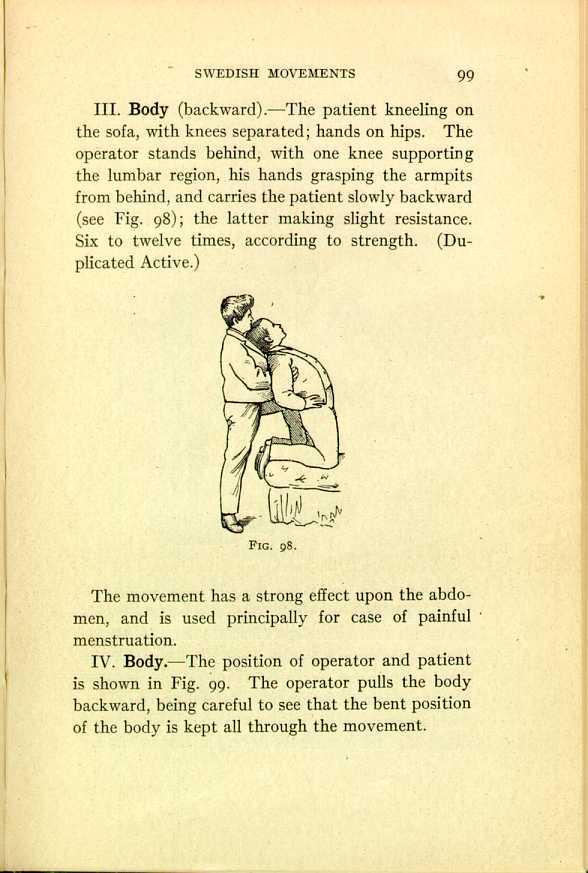
FIG. 98.
[Description: Drawing of an operator standing behind a kneeling patient, holding the patient's torso in a curved position. ]The movement has a strong effect upon the abdomen, and is used principally for case of painful menstruation.
- IV. Body.—The position of operator and patient is shown in
Fig. 99. The operator pulls the body backward, being careful to see that
the bent position of the body is kept all through the movement.
100
6. PULLING
- I. Foot.—The patient sitting or lying. The operator puts
one hand back of the ankle, the other grasping the toes and the front of
the foot, and turns the foot from side to side. The movement is always
passive, and is used chiefly for sprains and deformities.
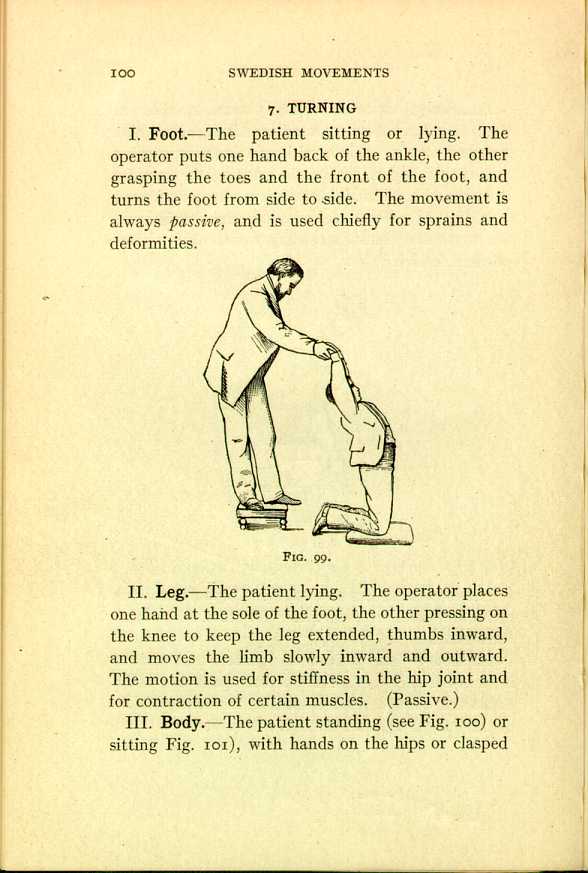
FIG. 99.
[Description: Drawing of an operator standing on a stool behind a kneeling patient, holding the patient's extended arms. ] - II. Leg.—The patient lying. The operator places one hand at the sole of the foot, the other pressing on the knee to keep the leg extended, thumbs inward, and moves the limb slowly inward and outward. The motion is used for stiffness in the hip joint and for contraction of certain muscles. (Passive.)
III. Body.—The patient standing (see Fig. 100) or sitting Fig. 101), with hands on the hips or clasped
on the back of the head. The operator, standing behind, places his right hand on one shoulder and his left in front of the other, and moves the patient to one side and back again, changing the position of the hands before turning to the other side. The movement is also duplicated active, and is used for congestion of the abdominal organs and for acting upon its great venous system.101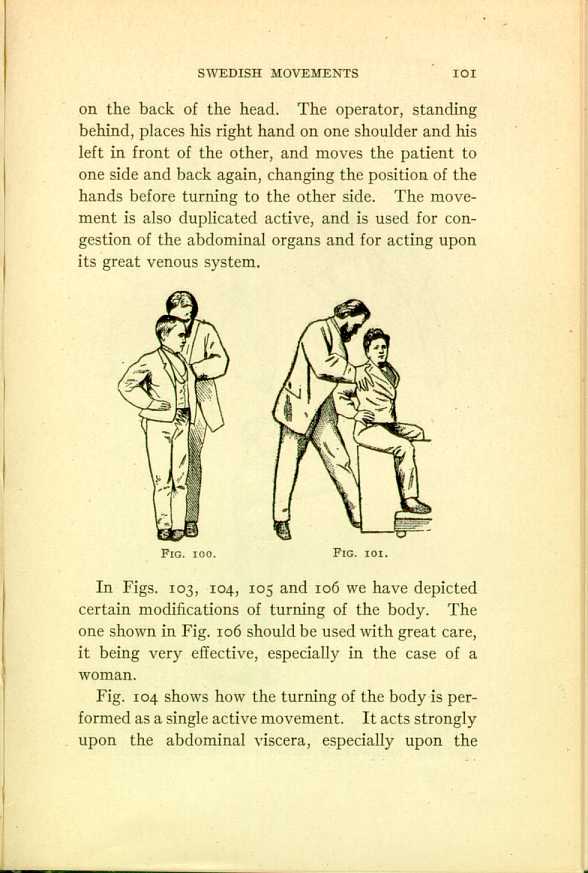
FIG. 100.
[Description: Drawing of a patient standing with his hands on his hips; an operator stands behind the patient, grasping the patient's arm. ]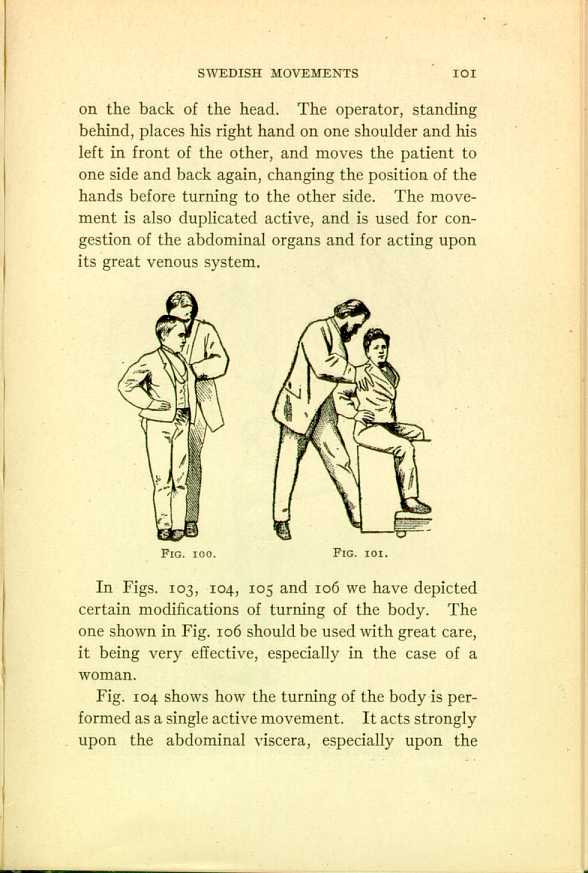
FIG. 101.
[Description: Drawing of an operator standing to the side of a seated patient, his right hand on the patient's shoulder. ]In Figs. 103, 104, 105 and 106 we have depicted certain modifications of turning of the body. The one shown in Fig. 106 should be used with great care, it being very effective, especially in the case of a woman.
Fig. 104 shows how the turning of the body is performed as a single active movement. It acts strongly upon the abdominal viscera, especially upon the
liver. The patient should be told to take deep breaths while performing the exercise.102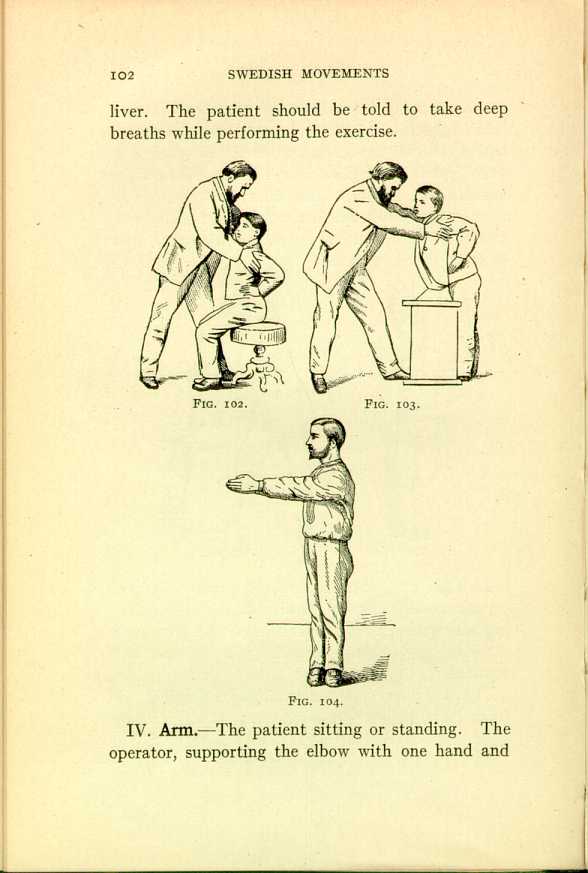
FIG. 102.
[Description: Drawing of an operator standing in front of a seated patient, his hands on the patient's shoulders. ]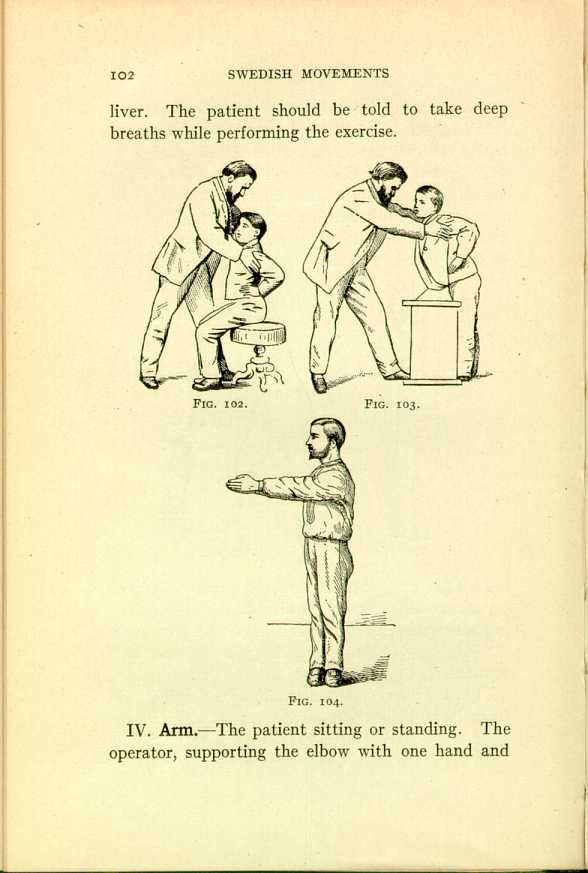
FIG. 103.
[Description: Drawing of an operator standing in front of a standing patient, his hands on the patient's shoulders. ]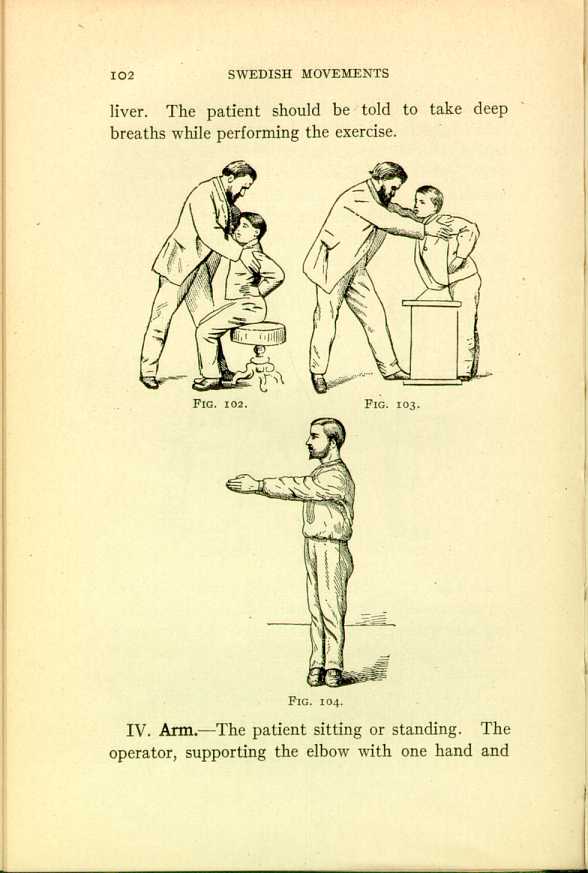
FIG. 104.
[Description: Drawing of a man with his hands extended, twisting his torso to the right. ]- IV. Arm.—The patient sitting or standing. The
operator, supporting the elbow with one hand and
103
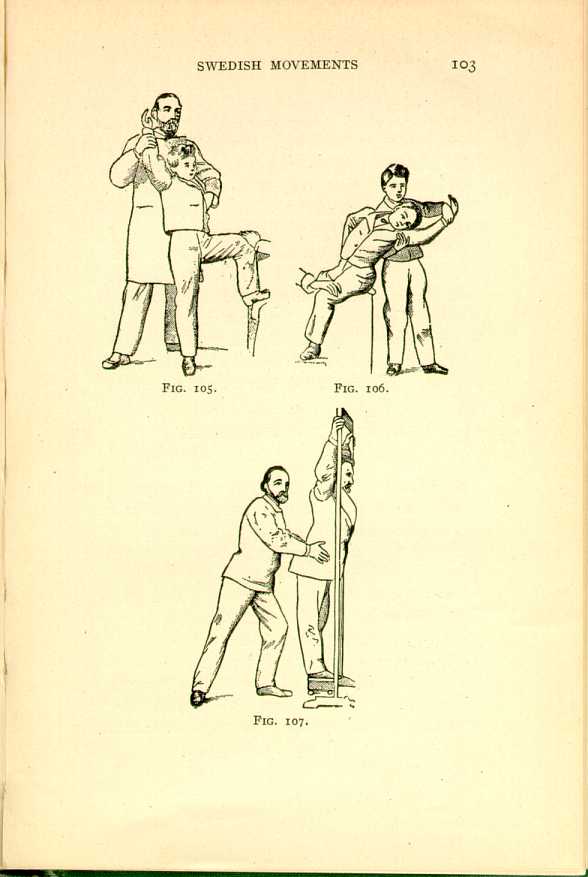
FIG. 105.
[Description: Drawing of an operator standing behind a patient, grasping the patient's extended arm. ]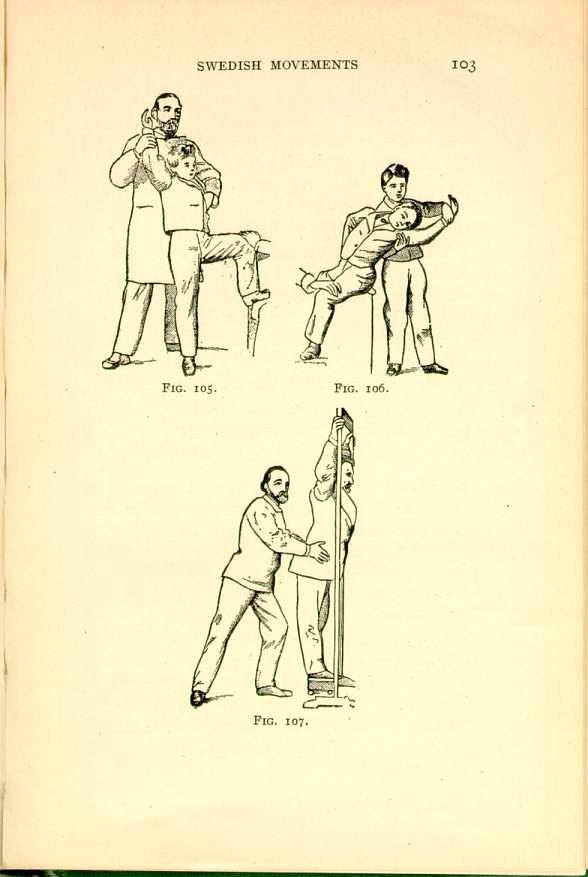
FIG. 106.
[Description: Drawing of a patient sitting on a bench, leaning to the side. An operator stands behind him, holding the patient's extended arm. ]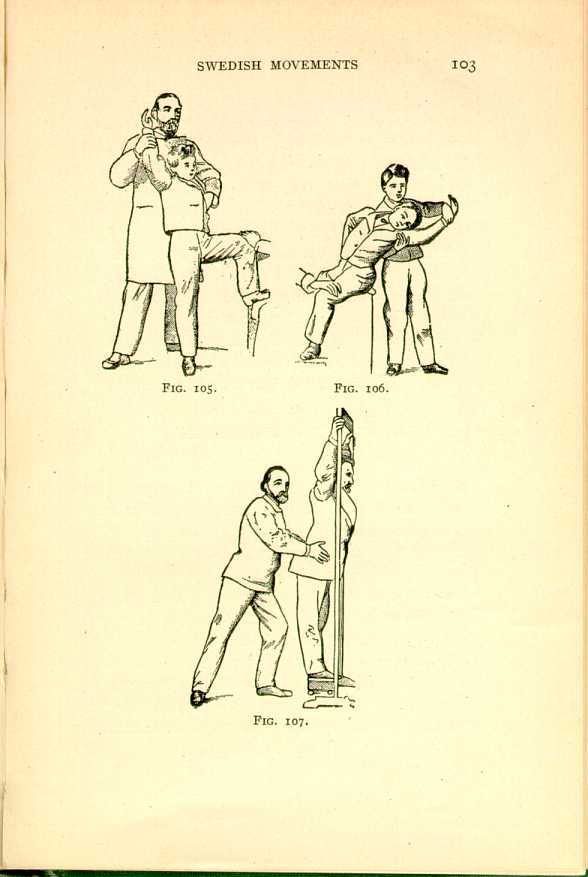
FIG. 107.
[Description: Drawing of a patient standing, his extended arms holding two poles. An operator stands behind him, grasping the patient's waist. ]grasping the hand with the other, turns the forearm from side to side (proration and supination). If the whole arm is to be turned, the operator must grasp the elbow to keep it extended. The movement is passive, and is used principally for stiffness in the joints and for relaxing the tendons and muscles in cases of after-operation.104 - V. Head.—The patient sitting. The operator, placing one hand on the forehead, the other on the neck, moves the head slowly from side to side. Ten times. (Duplicated Active, Passive.)
- VI. Pelvis.—The patient is in a position as shown in Fig. 107. The operator stands behind and resists the patient in his turning forward and backward.
7. TURNING
I. Arms.—The patient sitting or lying. The patient raises his arms, the operator grasping the hands from behind. The operator presses the arms down, the patient resisting. The patient raises the arms while the operator resists. Ten to twelve times. (Duplicated Active.)
In Fig. 108 is shown a form of depression and elevation of the arms in which the operator stands elevated in front of the patient.
II. Legs.—The patient lying flat on the back, grasping the bed or couch to keep himself immovable. The operator grasps the soles of the feet, thumbs inward. The movement is performed down and up
with the knees turned out, the patient resisting in the elevation and the operator in the depression.105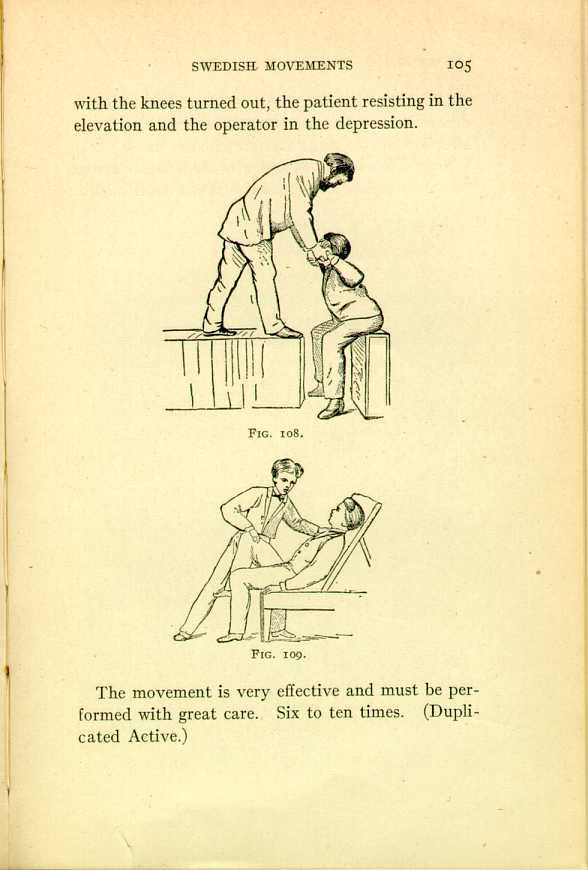
FIG. 108.
[Description: Drawing of an operator standing on a platform in front of a seated patient, holding the patient's raised hands. ]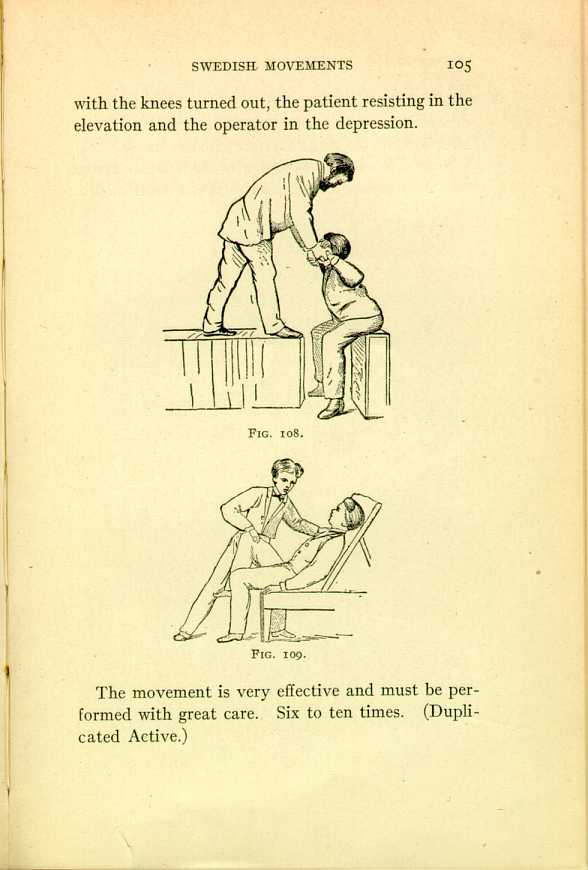
FIG. 109.
[Description: Drawing of an operator standing to the side of a reclining patient, holding the patient's knee. ]The movement is very effective and must be performed with great care. Six to ten times. (Duplicated Active.)
106- III. Leg.—In Fig. 109 we have demonstrated depression of the one leg, used for certain muscular affections in the thigh and around the pelvis.
8. DEPRESSION AND ELEVATION
Several movements belonging to the Swedish system have been omitted as not being of much practical use.
| Massage and the Original Swedish Movements | ||